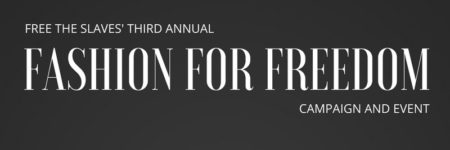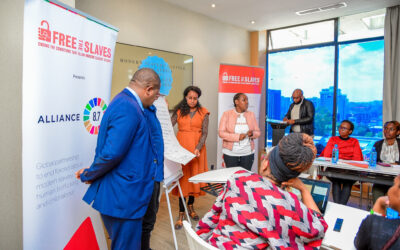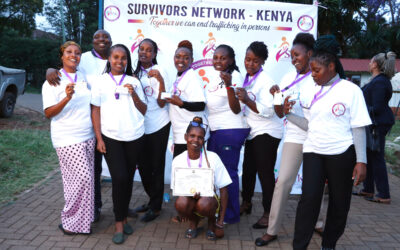The Free the Slaves Fashion for Freedom Campaign returns this summer to bring awareness to atrocity of modern slavery within the fashion industry. By bringing together brands and speakers that offer alternatives to questionably-made clothing, we will show that there are ethical options for those that wish to become conscientious consumers.
For many people, the word “slavery” conjures up images of a historical atrocity, rather than a modern evil. Few of us, as consumers, associate the word with the products we use or clothing we wear every day. However, recent research by the International Labor Organization has shown that not only are there more people in slavery today than ever before, but many of enslaved making products in ever increasing demand because of consumerism in society. More than half of the 40 million people in slavery today are trapped in forced labor, many in the garment and apparel industries.
The fashion industry enslaves and exploits millions of people around the world today – at all stages of a fashion supply chain, from fields where cotton is picked all the way to factories where garments are stitched.
Free the Slaves has long been fighting for build public awareness of modern slavery and acknowledgment of rampant slavery that is still at large within our society and catalyze a resurgence of the global abolitionist movement. While slavery is no longer legal anywhere, it still happens everywhere. Free the Slaves employs a community-based strategy to combat slavery. By working with local partners, the organization seeks to reduce vulnerability and increase access to education and training within communities in, or at risk of, falling into slavery. This allows those in bondage to help free themselves and sets them up for success further in life so that they are not at risk of slipping back into bondage.
The Fashion for Freedom Campaign follows a similar path but focuses on empowering consumers by making them aware of their own impact.
Fast fashion, a recent phenomenon, has led people to expect new and innovative designs to be released at breakneck speeds for relatively cheap prices. As consumers expect more products at lower prices, producers and manufacturers exploit individuals in order to increase production and limit the amount paid to laborers. Such practices inevitably lead to forced labor.
Many garment workers must choose between working in extremely unsafe conditions or having no job – and therefore no income to support themselves or their families. This is slavery, defined as a person who is forced to work, without pay, under threat of violence, who cannot walk away. At times, a factory worker’s inability to walk away is reinforced by a common practice of being locked in a room and having their passport taken away.
Unethical recruitment practices also lead many into situations of debt bondage slavery within the fashion industry. Often times, factory recruiters will charge a high price for job placement opportunities, and it can be near impossible for workers to pay back these debts. Poverty, gender and age can all contribute to vulnerabilities that create opportunities for such situations.
“Fashion victim” is no longer a term used to describe someone who wears an atrocious outfit. It is now more applicable to those exploited by the industry for their labor. It a term made possible by the $5 T-shirt that you find at a fast fashion retailer and immediately think, “God, what a deal,” and don’t question why an article of clothing is allowed to be made so cheaply. It’s the assumption that anything made in the U.S. is exempt from being part of the slavery chain. It’s thinking that all dangerous working conditions ended with the Triangle Shirtwaist Factory Fire of 1911 or the Rana Plaza building collapse in 2014.
The goal of the Fashion for Freedom campaign is to educate consumers that slavery is alive but there are ethical alternatives. There is no excuse for slavery. Through the Fashion for Freedom Campaign, Free the Slaves will expose this industry-wide issue and inspire consumers to stand for a change. It is time for consumers to ask “who made my clothes?” and “under what conditions?” In the words of Katharine Hamnett, it’s time we all ask one another, “Are you going to mindlessly go the easy way, or are you going to go the ethical way?”
See the Free the Slaves news release about the Fashion for Freedom Campaign here.
Dorothy Spingarn is a recent graduate of American University with a bachelor’s in anthropology and soon-to-be first-year law student at Hofstra University. Her interest in intellectual property and design rights in fashion led to her passion for human trafficking and ethical fashion. During her time at Free the Slaves, she was simultaneously writing her senior thesis, which focused on personal consumption of ethical fashion, in hopes to further understand the reasoning that consumers have for shopping the way that they do. She hopes to further this research to help change the way people shop. Her future plans include using her research and her law degree to affect how the fashion industry operates with respect to its workers and the ownership of cultural designs.




